


Paul d’Orléans (PDO): This Vincent build seems different to me, like you’ve made a big step forward in your work. It’s a very tight design, and the construction is mind-blowing. I called it your masterpiece on the Quail stage: what feels different for you about this bike?
Maxwell Hazan (MAX): Honestly this one was very difficult for me; there was Covid, I’d just had a kid and moved houses. Usually I can just be the recluse and sit in the shop until it happens. Now my life is like stepping in and out of character – that’s what I call it. It’s hard to walk in at 9 a.m. and say, okay, you’ve got until 5 make it happen. I don’t work on the weekends at all.
PDO: I was just reflecting on how we met in 2012, after you finished your first proper custom, a Royal Enfield, and were pondering building your second bike, mulling over what might be next. It was an interesting moment.
MAX: You know, I’ve never really said publicly that it was my dad who gave me the push to go full-time on building bikes. He said, “Hey, why don’t you give this motorcycle thing a real shot? Take some time off work. And if you need money, you know, for rent or whatever, I’ll help you out.” That was a surprise! My dad was always kind of a hard ass. But that offer gave me time and creative freedom, I could go any direction I wanted. The hardest part is, it’s such a blank canvas. And that’s where I struggled with the Vincent; making every single part from scratch, and all the little details; there are so many opportunities to make something right, and there’s a million wrong ways. And with the added responsibilities that I had, it was tough. After finishing the Vincent I started to experience a little burnout; it’s like a birth, and there’s something you leave behind with each one. Like it took something to figure out how to get that right shape.

PDO: Right? It’s a kind of magic that seems to support any good creative endeavor. You know; the thing you didn’t know you need appears in a flash of light.
MAX: Sometimes I really back myself in a corner and then all of a sudden an idea comes up and makes it seem like the whole thing was meant to be all along. Anyway, with that front brake I wanted the proportions to be just right, but as you saw it winds up being a tiny motorcycle. I’ve always tried to make the bike proportional, so if I want to scale the bike I’ll add things, so it’s functional but at the same time, it’s cool.

MAX: A lot of people said, ‘you needed to charge more for that.’ Honestly, Michael [Klingerman] does well, but he’s not Bobby Haas. I charged what I gauged I could for the client. But then again, how many builders out there have people lining up to pay six figure numbers? There’s not many. I just need to learn how to slow myself down a little bit. But you know how it works, to go to the Quail and and have that result, and seeing all these people geek out over the bike; it’s all worth it.
PDO: Well, it’s the old quandary for anybody who makes things, whether it’s art or furniture or whatever; what can you charge versus what do you really want to do? Making compromises for the money is kind of soul destroying, when you’re no longer doing what you want to do and lose interest in your own career. I speak from experience.
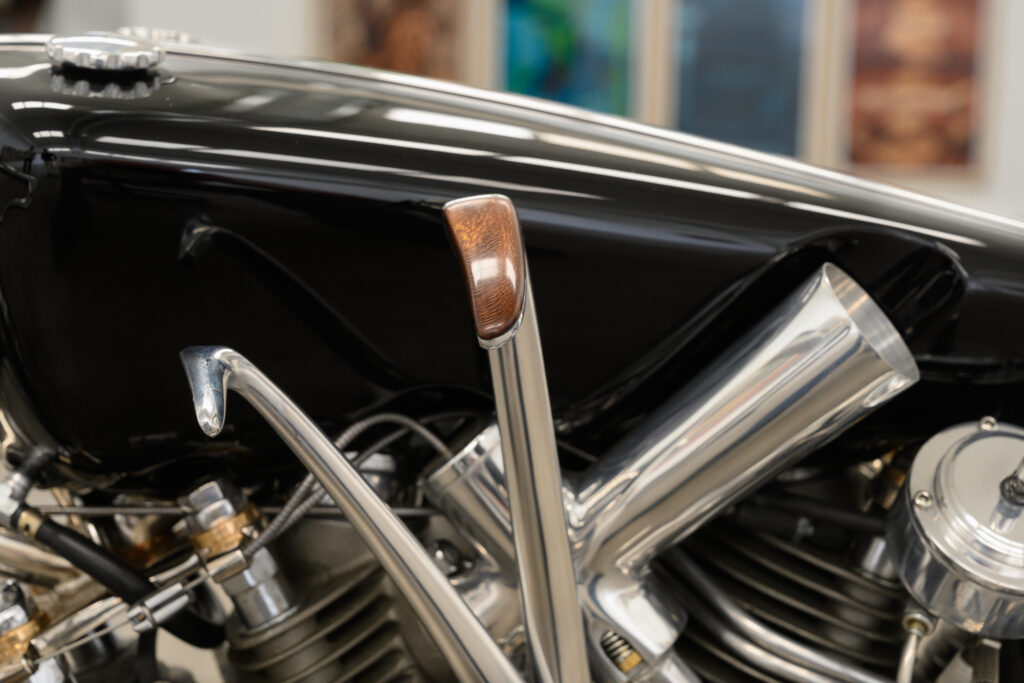
PDO: I saw that you’d made some engineering drawings for your parts. Do you use CAD or digital design software?
MAX: I actually don’t. I wish I knew more, and didn’t waste my time in college! But I can hand draw really quickly, and I can take measurements off of that drawing for something like the carburetors. When you draw a part out, you put your measurements down, and you also get an order of operations. With machining, it’s so easy to back yourself into a corner, thinking ‘I need to flip this part over, how do I find center, how do I grip it?’ You need to have the order in your head. And I’m still using manual tools, but I do have digital readouts on my machines, because one wrong turn on the knobs then you go a little too far and you’ve got start over.

MAX: Oh yeah. I’ve done that before. Some of the old-school people say, ‘oh, I don’t use a digital readout, I use the knobs.’ You know, the digital readouts are better. You can just set it and know that if you go past zero you went too far, right? And I try and use as many people as I can to help out with the process. I don’t do it by myself on principle. On the smaller stuff, I do it myself, but on the bigger stuff, I will have someone like Mark Atkinson [See his BMW Alpha from our Custom Revolution exhibit] CNC a part like the rear wheel from a solid chunk, and give me a blank so I can do the final operations on my machines.
PDO: You have a reputation as being humble. How does all the press feel to you? Will success ruin Max Hazan?
MAX: I’ve never been good at accepting it. I don’t have a problem with it, but it never sinks in. It never occurred to me to use a show win to mold an ego. I had a regular job and hated it, so I’m skeptical as this seems too good to be true, although now I have a little bit of job security, with a line of people who want my bikes. We’re not doing anything special here, it’s just way more fun than building houses. I never felt guarded about any of my stuff – if you want to build something like it, go ahead, it’s a lot of work!
PDO: That’s a question of character. Do you think you’ve Incorporated other builders’ ideas or shapes, or is your design process strictly intuitive?
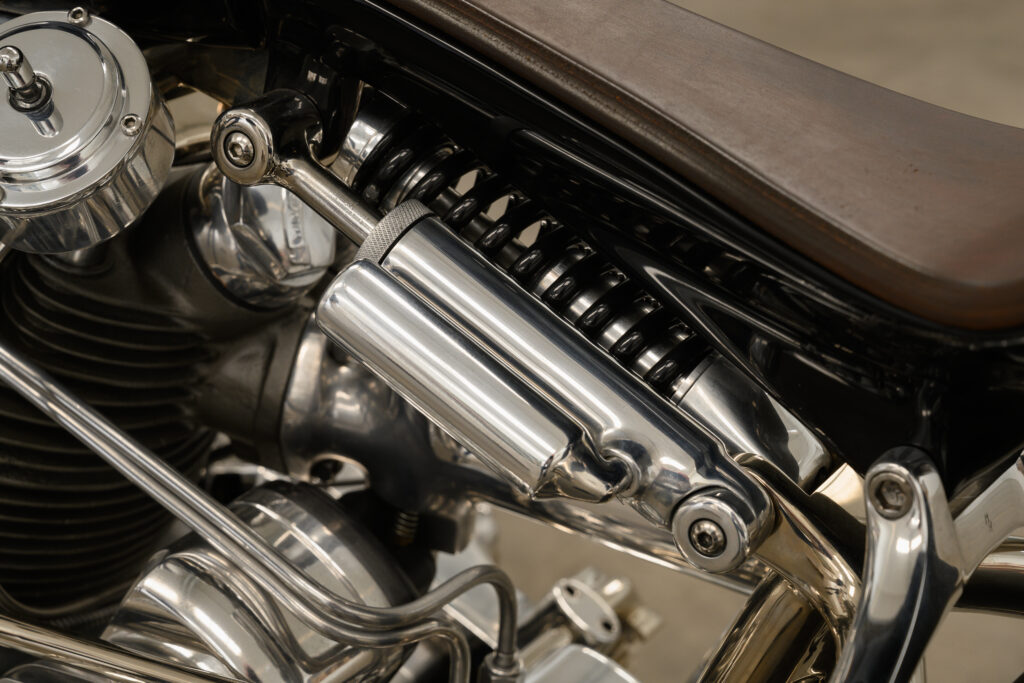
PDO: It’s your decision-making process that creates the style, that’s really what it comes down to.
MAX: It’s not like you’re necessarily trying to make things look a certain way. When you’re self-taught you figure stuff out on your own, and you inherently wind up with a different process and get a different outcome, because you’re winging it. So it’s not like “where did your Unique Style come from?” – it just came from what seemed like the best solution at the time.
In the very beginning I took inspiration from board track bikes, because I’d never seen them before; the big-diameter wheels and the proportions. I thought it’d be cool to make something like that, and one thing led to another.

MAX: Every now and then I write things down, and then randomly see them years later, and yes there was an engine list, and it sat in the back of my head. When I first started, I came across Brough Superior by accident. My mom’s last name is Brough, by marriage, so no family connection, just coincidence. I was looking for personalized Christmas gifts twenty years ago, so I type in Brough, and in the images pops up this engine, and I’m like, holy shit, that’s beautiful! And so I went down the rabbit hole until I found a price tag and I was like, okay, forget that! There was the Brough and the Vincent and a few other engines that I came across that were just beautiful but unobtainable, especially in the beginning, when I was building out of my own pocket. A lot of other projects were inspired by the dual front cylinder head setup on a [Harley-Davidson] XR750. I wanted to build bikes with two front cylinders, so I just did a much cheaper version, with ironhead Sportsters.
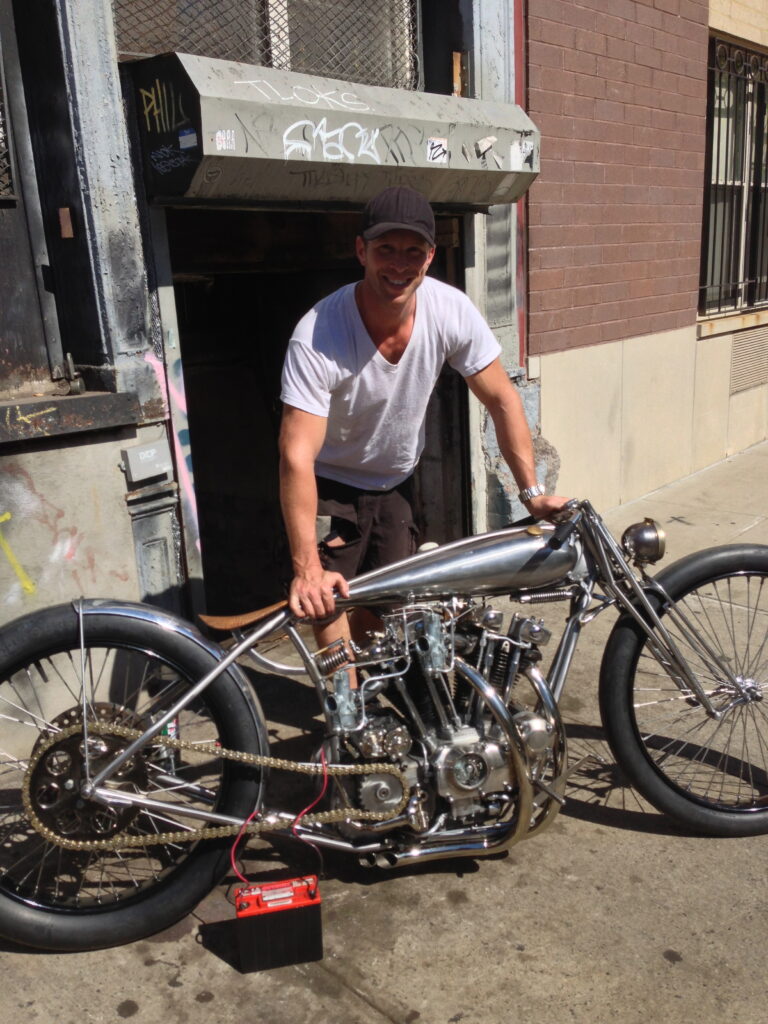
MAX: When I first started, I was buying complete running ironheads for twelve hundred bucks in New York. No one wanted them, as they were heavy and run like crap. But you know, they were cheap and they looked cool.
PDO: Well that’s one thing Harley-Davidson has always been good at: make it look badass.
MAX: So at one point I was wondering what my next project was going to be? And I got an email and then a phone call from from Mike. “Hey, I’ve got this Vincent engine. I think it’s all together. Would you like to build a custom motorcycle around it?” Get the fuck outta here! How does this happen? It just fell in my lap – I mean there was a little more to it than that – but I couldn’t believe it. He wheeled the Vincent engine into the shop, way in advance, so I could wrap my brain around it. He’d cleaned it up but I had no idea what was inside. It could have been just a total piece of shit. But I mean it was nice to have on my desk, just sitting there, for a year. When it finally came time I cracked it open and not only was it all there, it was all perfect. Someone had just put in a new pistons, new rings and everything was there. I wound up going with a higher compression pistons and a whole bunch of things, but it was a rare, easy starting point.
PDO: That’s amazing.

PDO: So, what was your education on building your own shocks and forks? I mean, you don’t have a degree in hydraulics, so how did you go about that?
MAX: Just common sense. I’ve got a mechanical brain, and understand the basics of how things work. When I was racing I’d watch these suspension techs spouting the biggest lines of bullshit. I’d ask ‘ever try this?’, and they’d say, ‘well, you know, you can’t do that.’ And how many times have I just said, you know what? I’m just going to get the screwdriver out and turn a few clicks and bounce it up and down until I feel like it’s right. With the Vincent, it was actually pretty easy. I had the damping rod and the seals and the springs, and I just messed around. I bought a whole bunch of different springs because it’s easier to buy springs and test them out than it is to sit there and try and calculate it. As far as the damping goes, there’s a Teflon disk that acts as a slider, and also it has holes in it [for the fork oil to pass through], so I made a few different ones with different holes. The forks feel amazing, I don’t know how I got it so on the money, I surprised myself with that one.
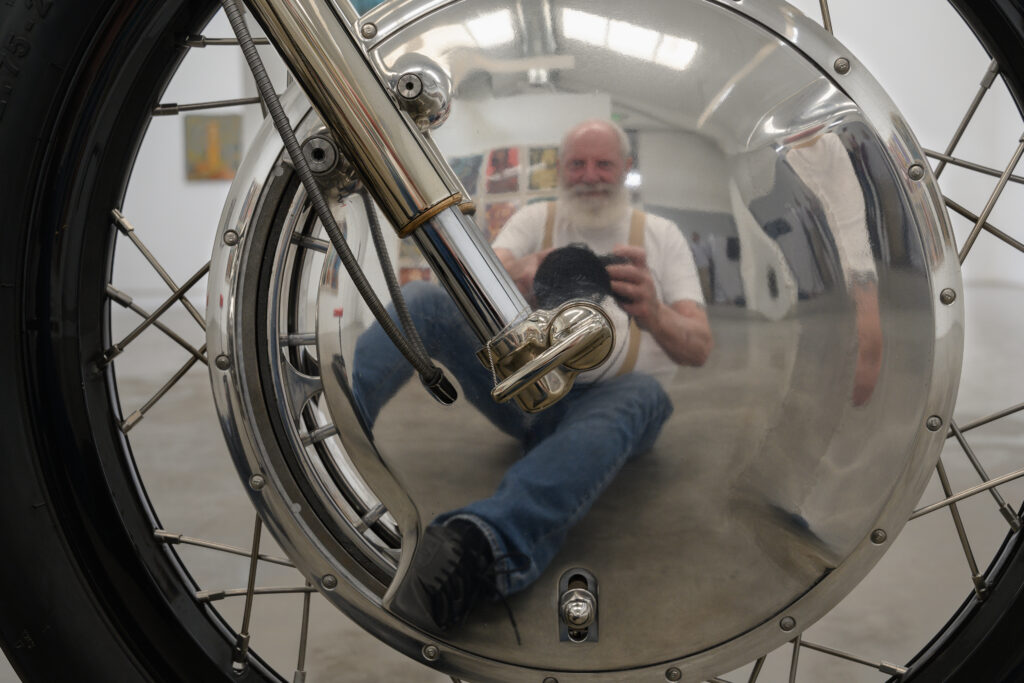
MAX: Honestly, I don’t make any secret, McMaster-Carr is the best website of all time because, you know, they have a million different types of seals and wipers, all this crazy stuff for building hydraulics. I would have bought an off-the-shelf hydraulic shock if I had found one that works on the Vincent. But suspension companies can be such a pain in the ass to deal with, condescending and with a narrow-sighted approach, ‘What are you doing? You definitely can’t do that.’ First of all, you can, and second of all, I just needed to know this one bit of knowledge from you. After being frustrated enough times, I just thought, it’s a hydraulic shock, we’ll figure it out.
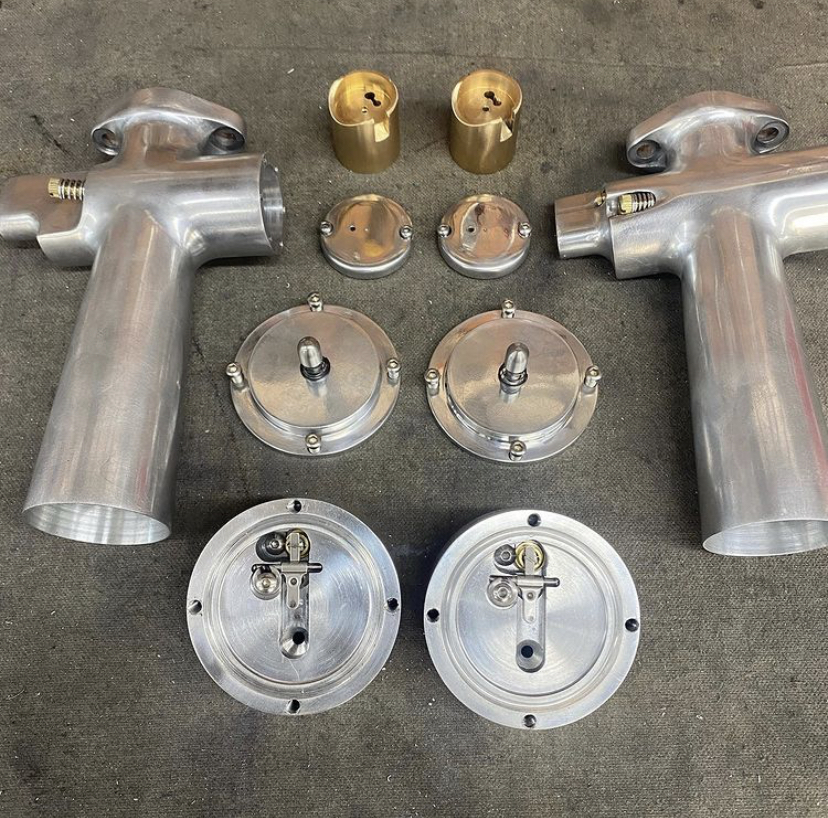
MAX: It’s incredible when you actually meet like-minded peers. I don’t meet that many people with that same approach, or who have gone through the same experience. I met a famous Porsche builder when I was going to machine this massive drum brake. And he was partners with this crazy aerospace guy out in Palmdale, like really well known, building crazy, crazy stuff. He’s an engineer, and I started talking to him and he was way smarter than me, but so nice. Somebody who I could throw the craziest ideas to, and he’d say ‘yeah I like that. Let’s do that. We’ll figure that out.’
PDO: Not many people have invested a time in in creative thinking, and creative problem-solving. It’s rare to find a person who’s just making things and figuring out how to make it work, from a set of shocks to building a motor from scratch. Everything is possible, and obviously somebody thought it up in the first place.
MAX: And one big thing is, don’t be scared to screw up. Just to go for it, man. Like the amount of time you waste thinking whether you should do it or not, you learn so much more from a mistake than you do from going back and forth, or reading a bunch of stuff. If I don’t take the chance, I’ll never know. So, I just kind of jumped in and luckily now with just a little bit of experience, most of the time it works out, the mistakes are fewer and smaller.

MAX: You know, honestly, I always do something unique with each bike. Originally I bought a pair of Dell’Orto SS1s, but on the Vincent they just looked like a dog. What was in my head was velocity stacks. The carburetors are just a mechanical object, you’ve got to machine a few things and, you know, it’s been made by a human. It’s not impossible. So I sat down and measured a few carburetors to see some of the proportions. I measured the inlet tract, the inlet flange was 28mm, so that’s how big the carb is going to be, and I sat down and started drawing. There are so many little passages inside that have to make a 90degree turns and hit the next passage. You don’t want them to intersect at some random point in the casting. I stole a couple of little things from many different carbs; a mixing tube, the needle and a jet. I didn’t need to make the needle!
PDO: And are those floats behind the carbs?
MAX: Remote floats are sensitive to height; they have to be in line with a certain level of the carburetor. Otherwise, it’ll either just dump fuel out of the carburetor, or not get enough fuel. And wherever I put them, they looked like crap. I had an idea I’d seen on a jet ski, a vacuum-operated diaphragm. I thought that would be cool, so grabbed the diaphragm out of a Mikuni carburetor and machined the housing. They use them on chainsaws too, and you can turn a chainsaw upside down and it still runs. So I just gave it a shot. I wondered if I went a little too far, but once I got it within the range where it would run, and then it was responsive to turning the idle screw, I knew I was good. The main thing is, it’s using the suction in the mixing tube, not the manifold vacuum; it’s actually picking up the vacuum in front of the slide. So as your carburetor wants more fuel, it produces more vacuum, and I just couldn’t believe how well it worked. I took it out and rode it with a digital O2 sensor on, and you just turn the throttle and get the normal throttle response, but the air / fuel ratio never moves. It’s pretty cool.

MAX: If it’s real hot out side, or even idling for a while at a light, you might have to keep on the throttle a little bit.
PDO: I have to do that with all my old bikes – I’ve always got a hand on the throttle!
MAX: I’m happy Mike is so enthusiastic and happy with the Vincent. When I saw his face at the Quail it was like, yeah. I knew damn well I should have charged double for this bike, but when it was all done, I forget all that. And I’ll do it again, I’m sure.






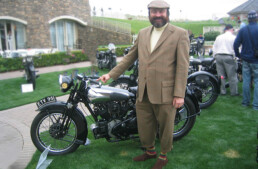
Modified bikes and customs are not my thing, but this one is really well made, not a pile of
parts assembly, just good for the aesthetic. Oh, yes the “upside down” fork name amuse me as those forks are
exactly as Magnat Debon designed them in 1910, and used later by Nimbus and BMW: simply in the GOOD sense!
Friendly Jacqui
Finally .. something real !
Take some Vincent bits and bobs .. hand em over to Max Hazan …. and voila … damn near custom M/C perfection . Not there quite yet mind you ( its a moving goal post ) but damn near as Max has gotten to date
As for anyone denouncing customs built out of legendary classics I say once again repeating the words of the GREAT US Vincent sage and legend ( Big Sid Biberman )
” Stock is a can of beans on a shelf ”
😎
PS; Any bets Hazan’s HMW would tear the beak and claws off of Falcon’s poorly engineered Black Falcon .. both on the road and aesthetics wise ?
Hmmm …. thought not !
Damn Black Falcon .. a custom M/C opportunity missed if there ever was one
And who’s come closest to custom motorcycle perfection in my never ever humble estimation ?
Chicara Nagata .. who’s bikes are painfully beautiful .
Can Hazan catch up or even surpass Nagata-san ? Suffice it to say he’s got the chops .. has the focus .. and definitely the ability to do so . Question is … can/will he keep chasing that ever moving goal post ?
PS; Couple of motor suggestions for Hazan to consider . The Indian Four … and that insane Aussie radial triple .
Hi Paul,
I just don’t get your eulogising of the HMW Vincent.
As a former Vincent owner – a Comet as my everyday bike and a genuine Egli Lightning spec twin – sadly victims of divorce – I can’t see why someone would build a bike like that.
Everything is wrong about it: the workmanship may be good but the engineering – complete lack of actually – is unforgivable.
Where to start? Forks that belong on a BSA Bantam, a front brake that would snap the forks if used at more that walking pace, a riding position that is just silly and unusable, the whole chassis/wheel/suspension relationships simply nonsensical.
Obviously it was never meant to ridden, so what is the point it? Just to stand it in the corner of the living room?
And a Vincent probably taken off the road – we need all we can get out there.
After all, they were built to ride and race, both of which they did wonderfully well.
To just collect dust? No, they deserve better than that.
But thanks for The Vintagent, it’s always interesting.
Cheers,
Rod
Hi Rod,
Thanks for your note!
My thoughts:
Max’s bike is not meant to be another cafe racer or stock machine – there are how many thousands of stock Vincent twins around? Another perfect restoration or Egli repro does not move the needle culturally or attract a new audience to the old bike scene.
This bike does.
It attracts huge attention, which means eyeballs on old bikes. Given the truly sad state of our two-wheeled passion – and I speak as a nine time president of the Velocette owners club, and 30 year member of the Brough club – we desperately need to attract younger people into old bikes. The neo-custom/BikeExif scene has done that more than any concours or club event, putting tens of thousands of young people in the saddles of older bikes, and millions wishing they could.
In short, by making motorcycles cool again.
Max builds artworks. They’re his expression of something he deeply loves about motorcycles, that moves him to make these functional sculptures. They’re by his own description mechanical art: he’s not building them for performance.
While some folks decry the use of a Vincent engine thus, I could point them to two dozen loose Rapide engines sitting dusty on shelves, and a hundred perfectly restored Rapides that are never ridden at all. The reason there are still so many basket case Vins is not because they are expensive – it’s because there are more Vins than people interested in them, or capable of fixing them, or willing to ride them. Reputation is a double edged sword – people are scared to ride their Vincents – but the bottom line is, they’re just motorcycles.
We desperately need to get the kids interested in old bikes. I’ve supported the custom scene for exactly this reason; after investing 40 years into vintage motorcycles, I see customs as the best shot we have for new blood. It’s definitely worked.
All the best, Paul
Paul, thanks for sharing this interview. Max, as inspiring as ever in your attitude and approach. I especially relate to painting yourself into a corner and having to work yourself out of it – it’s a bit stressful but usually works out in the end. The status quo is comfortable so if you’re not feeling a little bit uncomfortable you’re probably not pushing yourself. Keep on keeping on! Hugo
Paul,
I understand what you are saying but, young people are not interested in old bikes unless it’s a Triumph Bonneville. And even then most would rather have the new version. They neither have the money to buy a Vincent or the mechanical skills to keep it running.
I have about 30 old British and Italian motorcycles including two Velocettes. When they get ridden, younger riders pay no attention.
The quality of the workmanship is incredible but, if it’s not made to be ridden, it’s not a motorcycle. I never understood back when Cycle World magazine would feature these kind of bikes that can’t be ridden!
I remember at the Del Mar motorcycle show years ago when Dave Edwards was judging the custom bikes, that he asked some of the owners to start the bike and see if it even ran. Most of the owners said no as the bikes had no gas in the tank. He offered to provide gas but they still said no.
This bike looks like it may have a rear brake, but I can’t see how it is even operated?
Also the rear magneto (look like a Joe Hunt magneto) has a toothed belt sprocket on it but no drive belt?
He is very talented but is he wants to make a custom Vincent, make it better than Vincent did and make it ride able.
Now most Vincents are never ridden (probably 99% just collect dust) but at least they could be ridden.
Back when people started customizing bikes in the 1940’s they were trying to make them lighter and faster. When someone made a bobber Harley they were not trying to make a cool bike just something faster than the factory did. Not something they could no longer ride.
Anyway off of my soapbox. I am glad you put it on you website. Interesting to see how much work went in to making something you can’t ride.
Hi Bruce,
well, I guess nobody has offered you a ride on an exotic custom bike? I’ve ridden quite a few of them – all of the Falcons, a lot of Shinya Kimura’s bikes, several other less well-known builders. I’ve also exhibited quite a few customs in various shows at the Petersen, Sturgis, etc: you can always tell which ones were built well, versus the ones just for show, simply by pushing them into position for display. Some work beautifully, and some are clearly an aesthetic statement only. As an artist myself, I respect an aesthetic statement too. But as a rider, I do prefer a motorcycle that can be ridden.
I haven’t ridden Max’s Vincent, but I’ve seen him fire it up and ride it. That magneto is not belt-driven, but gear-driven off the clutch. The clutch is activated by a lever on the shifter, and is amazingly light. Max’s bike works, but I’d agree it’s weighted more toward an aesthetic statement than a 100,000 mile motorcycle. Still, it might get ridden more than 99% of the dust-collector Vincents? He says his home-make suspension works beautifully and is very supple, and I’m inclined to believe him, as he rides all sorts of bikes in his off hours.
It might be a lost cause, thinking it’s possible to get a younger generation interested in old bikes. But, it’s worth the effort, and I’ve definitely watched the uptick of interest in motorcycles generally due to the energy of the custom scene. That’s a story going since around 2010, and the demographics of BikeExif and books like The Ride prove my point.
all the best, Paul
For me, less being more includes the least amount of costumizing on my rides, nigh close to the factory’s end product. An item’s rarity is not the key, but my story with it is. As soon as a motorcycle is owned and ridden, it becomes a unique combination of rider and machine. All of them. So, why bother with the pursuit of gold? It’s just metal. But I do appreciate all the other views, as they produce works of absolute joy to be witnessed, and at approximately zero cost! Thank you!